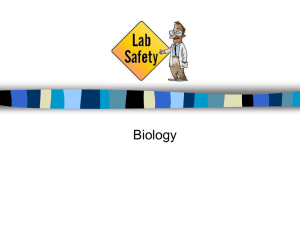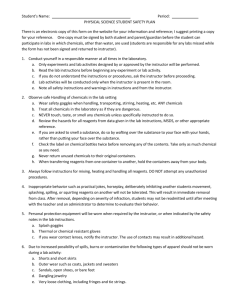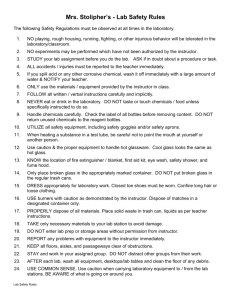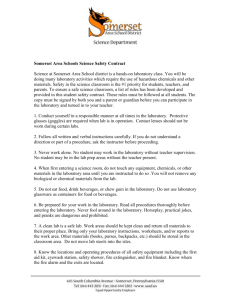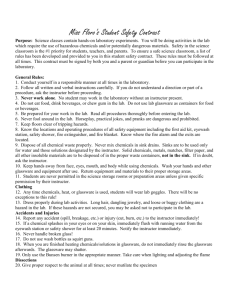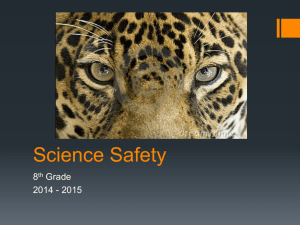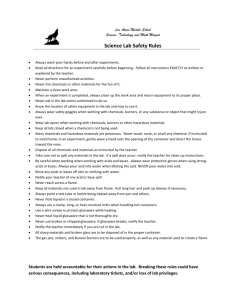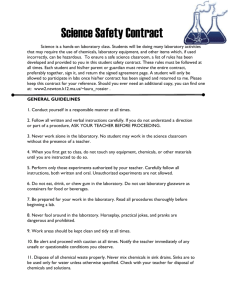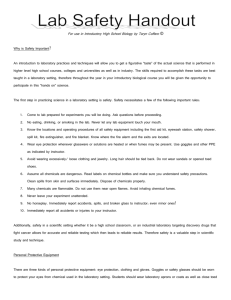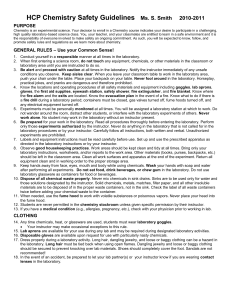Chemistry Lab Safety Guidelines & Contract
advertisement
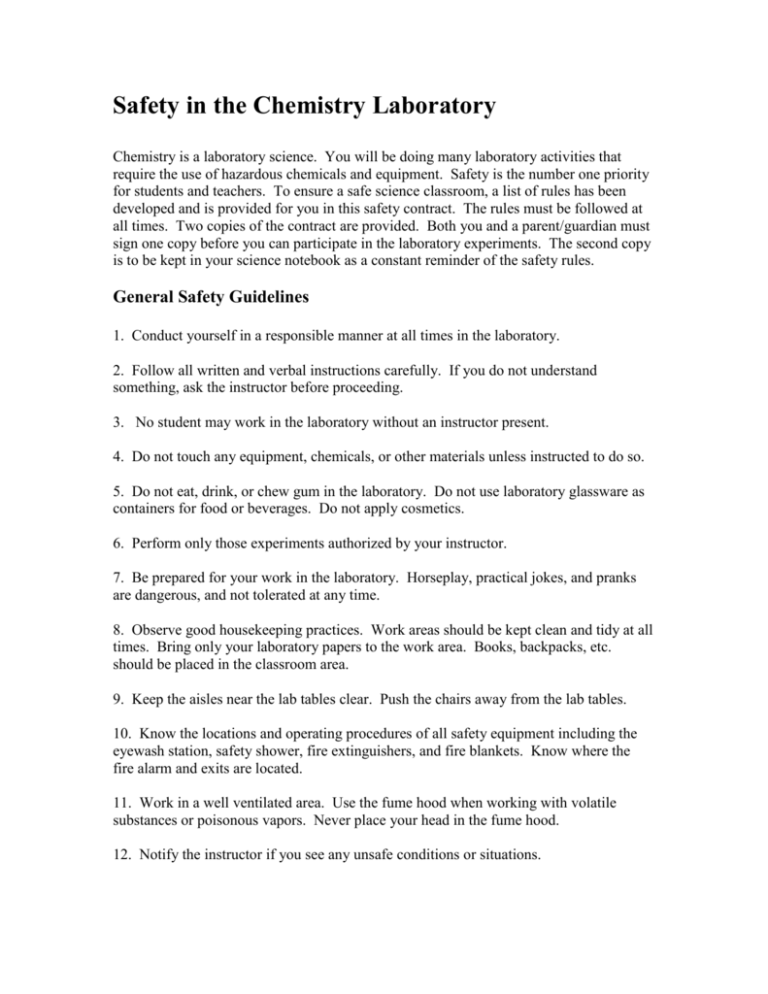
Safety in the Chemistry Laboratory Chemistry is a laboratory science. You will be doing many laboratory activities that require the use of hazardous chemicals and equipment. Safety is the number one priority for students and teachers. To ensure a safe science classroom, a list of rules has been developed and is provided for you in this safety contract. The rules must be followed at all times. Two copies of the contract are provided. Both you and a parent/guardian must sign one copy before you can participate in the laboratory experiments. The second copy is to be kept in your science notebook as a constant reminder of the safety rules. General Safety Guidelines 1. Conduct yourself in a responsible manner at all times in the laboratory. 2. Follow all written and verbal instructions carefully. If you do not understand something, ask the instructor before proceeding. 3. No student may work in the laboratory without an instructor present. 4. Do not touch any equipment, chemicals, or other materials unless instructed to do so. 5. Do not eat, drink, or chew gum in the laboratory. Do not use laboratory glassware as containers for food or beverages. Do not apply cosmetics. 6. Perform only those experiments authorized by your instructor. 7. Be prepared for your work in the laboratory. Horseplay, practical jokes, and pranks are dangerous, and not tolerated at any time. 8. Observe good housekeeping practices. Work areas should be kept clean and tidy at all times. Bring only your laboratory papers to the work area. Books, backpacks, etc. should be placed in the classroom area. 9. Keep the aisles near the lab tables clear. Push the chairs away from the lab tables. 10. Know the locations and operating procedures of all safety equipment including the eyewash station, safety shower, fire extinguishers, and fire blankets. Know where the fire alarm and exits are located. 11. Work in a well ventilated area. Use the fume hood when working with volatile substances or poisonous vapors. Never place your head in the fume hood. 12. Notify the instructor if you see any unsafe conditions or situations. 13. Dispose of all chemical waste properly. Solid metals, matches, filter paper, and other insoluble materials are to be disposed of in the clay crocks provided. Your teacher will tell you how to dispose of the soluble waste. 14. Set up and use the apparatus as described in the lab manual or by your teacher. Never use makeshift arrangements. 15. Keep your hands away from face, eyes, and mouth while using chemicals. Wash your hands with soap and water after performing all experiments. 16. Students are never permitted in the science storage rooms or preparation areas. Exception: in room 116, the safety shower/eyewash is located just inside the door of the storage room. Students on fire or with chemicals on them are allowed to use the safety equipment in this case. 17. In case of a fire drill, burners must be turned off, hot plates unplugged, and open containers closed. Quickly do this so that you may exit the room promptly. 18. When using sharp instruments, always carry with tips pointing down and away. Always cut away from your body. Never try to catch falling sharp instruments. Grasp sharp instruments only by the handles. 19. Safety goggles and a lab apron should be worn at all times. Students wearing contact lenses should be especially careful of this rule since chemicals can become trapped between the contact lens and their eye. 20. Long hair should be tied back or covered, especially in the vicinity of an open flame. 21. Jewelry that might present a safety hazard such as dangling necklaces, chains, medallions, or bracelets, should not be worn in the lab. Put your jewelry in your book bag rather than on the lab table so that it does not become soiled or lost. 22. Shoes must completely cover the foot. No flip-flops or sandals will be allowed. 23. Report any accident (spill, breakage) or injury to the instructor immediately. 24. If a chemical should splash in your eye or on your skin, immediately flush with running water from an eyewash station or safety shower for at least 15 minutes. Notify the instructor immediately. 25. All chemicals in the laboratory are considered dangerous. Do not touch, taste, or smell any chemicals unless specifically instructed to do so. The proper technique for smelling chemical fumes is to wave your hand across the opening in a wafting motion. Sniff the fumes gently, rather than taking deep breaths. 26. Check the label on the chemical bottles twice before removing any of the contents. Never return unused chemicals to their original container. 27. Never use mouth suction for liquids. Always use a pipette pump or rubber bulb. 28. Always do what you oughter and add acid to water. Swirl the solution carefully since the mixing of acid and water produces heat. 29. Never use flammable liquids near an open flame or source of heat. Always use a hot water bath when heating a flammable liquid. 30. Never remove chemicals or other materials from the laboratory. 31. Glass tubing, especially long pieces, should be carried in a vertical position to minimize the likelihood of breakage and to avoid stabbing anyone. 32. Never handle broken glass with your bare hands. Use a brush and dustpan to clean up broken glass. Dispose of broken glass in the designated container. 33. Always lubricate a piece of glassware (tubing, thermometers, etc.) with water or glycerine before attempting to insert it in a stopper. Protect your hands with a towel. 34. Never apply force when inserting or removing glassware from a stopper. Use a twisting motion. If a piece of glassware becomes “frozen” in a stopper, take it to your instructor. 35. Do not place hot glassware directly on the lab table. Always use an insulating pad. 36. Allow plenty of time for hot glass to cool before touching it. Hot glass looks like cool glass. Determine if an object is hot by bringing the back of your hand near it. 37. Hot glassware may shatter if it is immersed in cold water. 38. Examine glassware before each use. Chipped or cracked glassware can shatter when heated. If glassware is dirty, clean it before use. 39. Exercise extreme caution when using a gas burner. Keep your hair and clothing away from the flame. 40. Never leave a lit burner unattended. Never leave reacting chemicals unattended. Always turn off the burner or hot plate when not in use. 41. When heating a substance in a test tube, make sure the mouth of the tube is not pointed at yourself or anyone else. 42. Never heat a closed container. Never look into a container being heated. 43. Never heat anything without being instructed to do so.
